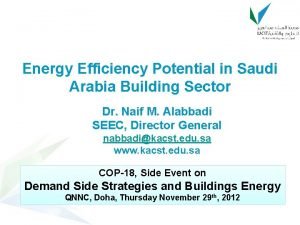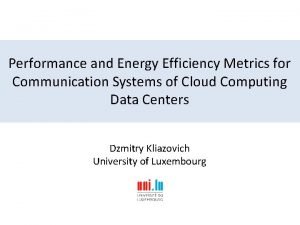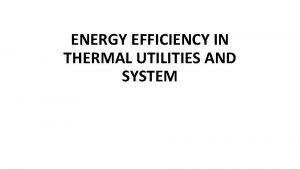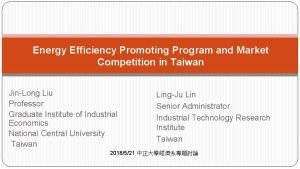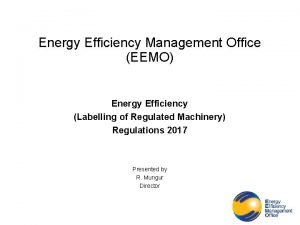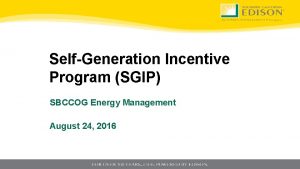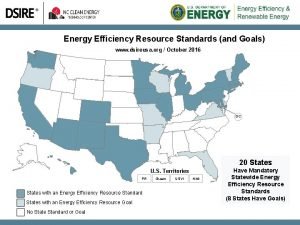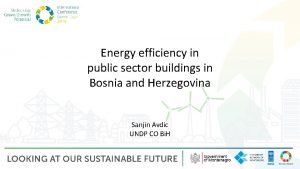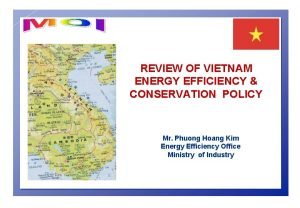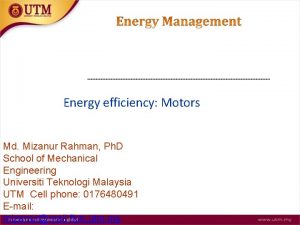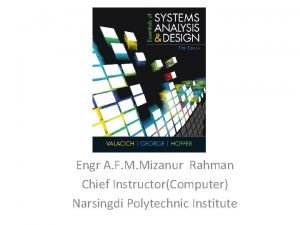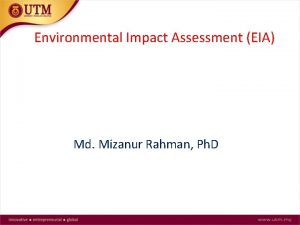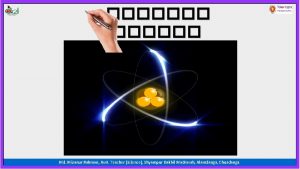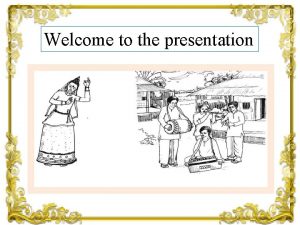Energy Efficiency Md Mizanur Rahman Ph D CEng



















- Slides: 19

Energy Efficiency Md. Mizanur Rahman, Ph. D, CEng Chartered Energy Engineer School of Mechanical Engineering Universiti Teknologi Malaysia UTM Cell phone: 0176480491 E-mail: mizanur@mail. fkm. utm. my

Energy efficiency is the major tool to deal with the energy sector challenges Supply side efficiency Demand side efficiency Energy efficiency is a ‘fuel’ indeed Energy efficiency involves a wide range of actions across different sectors and energy services Difficult to quantify, priced and traded Ref: WEO 2012 p 282 2

Global energy-related CO 2 emissions abatement in the 450 Scenario relative to the New Policies Scenario Ref: WEO 2012 p 253 3

Efficiency accounts for 50% of the cumulative global abatement share relative to the New Policies Scenario 450 relative to new policies scenario Ref: Energy Efficiency Technologies: Overview Report World Energy Council 2013 P 10 4

Energy Efficiency Across the Entire Energy Value Chain 5

• Energy system based on energy efficiency approach requires optimal integration of all components resulting in an integrated energy system. In order to setup the integrated energy system three tasks have to be completed: 1. Identify and specify actual energy requirements. Review possible options (technical, economic, behavioral, policy etc. ) for efficiency increase along the entire energy conversion chain and select the most appropriate to match your requirements. 3. Optimize the system using tools such as Information & Communication Technologies, e. g. Control, Real Time Optimization and Smart Grid Technologies across sectors and infrastructures along the energy chain. 2. 6

• Energy efficiency in oil & gas exploration – The O&G is consuming about 20% of its output for its own process needs. – Energy efficiency of O&G Exploration is low by any standards, as it hardly reaches 20%. Compared to the state-ofthe-art power generation technology reaching over 60% efficiency 7

Efficiency in thermal power generation • In coal-fired power generation efficiencies around 46% are being reached today. • The average efficiency of gas and coal fired plant across the world is approximately 41% for gas and 34% for coal. • There is a huge efficiency gap between practice and state-of- the art. 8

Net efficiencies of coal-fired compared to state-of-the-art 9

Boosting efficiency through smart grid • The paradigm shift in the electricity system Increasing electric distribution efficiency, Facilitating changes in customer behavior Energy management systems. Reducing operating costs from capabilities such as remote meter reading • Reductions in environmental impact through two sources: conservation and greater renewable generation integration • • 10

Efficiency by co-generation • Various industries generate steam and electricity for subsequent use within their own facilities. • Co-generation converts up to 90% of fuel into usable energy. 11

Energy efficiency in transportation • Electric vehicles (all electric or hybrid electric). • Regenerative breaking to recapture energy that would dissipate in normal cars • Plug-in hybrids also have increased battery capacity, which makes it possible to drive for limited distances without burning any gasoline 12

Pumping • Pumping accounts for about 14 % of global industrial electricity use. • Means of improving the energy efficiency of pumping include: reducing flows through VSDs reducing flows through effective time control improving gears and transmission

Compressed air • Air compression, in which compressors are a major component, accounts for about 17 % of global industrial electricity use. • Means of improving the energy efficiency of air compression include: – reducing air leaks – reducing air pressure (approximately 7 % energy reduction per bar) – converting into electric tools where possible – using VSD compressors

Ventilation • Ventilation (fans) accounts for about 11 % of global industrial electricity use • Means of improving energy efficiency of ventilation: – reducing air flows through VSD (variable speed drive) – reducing air flows through effective time control – Heat recovery

Internal transport (within the industrial site) accounts for a small portion of the energy and electricity used in industry. Means of improving the energy efficiency include: Converting from diesel and gasoline vehicles into more energyefficient ones (e. g. , electrically powered) Maintaining adequate tire pressure Improving production planning to reduce transport distance Optimizing storage location to reduce transport distance

• More energy efficiency in: – Lighting – Electric motor – HVAC – Heat pump etc. We will see these in more detail ….

Energy efficiency: The Rebound Effect • The direct rebound effect: a price effect where a new technology might increase energy efficiency corresponding to a reduction in the price of energy services that leads to an increased demand for energy. • The indirect rebound effect: which means that an energy efficiency activity lowers overall energy costs leading to more money left to spend on other goods and services.

Group discussion Discuss with your friends about fossil fuel based energy (5 minutes) 1. About 50 -75% of input energy in fossil fueled power plants is wasted as exhaust … 2. Fossil fueled power plants produce SOx, NOX, particulate matters, toxic organic and inorganic by-products which are very harmful to the public health. . 3. Globally less than 10% electricity comes from renewable sources. . 4. Resource depleting rapidly. . What should we do? 19
 Md mizanur rahman pilot
Md mizanur rahman pilot Md mizanur rahman dream paris
Md mizanur rahman dream paris Mizanur rahman
Mizanur rahman Mizanur rahman
Mizanur rahman Renewable energy and energy efficiency partnership
Renewable energy and energy efficiency partnership Allocative efficiency vs productive efficiency
Allocative efficiency vs productive efficiency Productively efficient vs allocatively efficient
Productively efficient vs allocatively efficient Allocative efficiency vs productive efficiency
Allocative efficiency vs productive efficiency Energy energy transfer and general energy analysis
Energy energy transfer and general energy analysis Energy energy transfer and general energy analysis
Energy energy transfer and general energy analysis Saudi energy efficiency program
Saudi energy efficiency program Data center energy efficiency
Data center energy efficiency Energy efficiency in thermal utilities
Energy efficiency in thermal utilities Taiwan energy efficiency label
Taiwan energy efficiency label Energy efficiency management office
Energy efficiency management office How much energy is transferred between trophic levels
How much energy is transferred between trophic levels Sgip rebate step 6
Sgip rebate step 6 Energy efficiency
Energy efficiency Public sector buildings energy efficiency
Public sector buildings energy efficiency Vietnam energy efficiency label
Vietnam energy efficiency label










